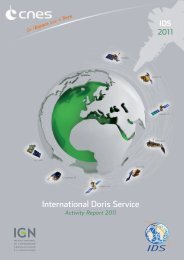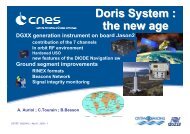The International DORIS Service July 2003 – December 2005 report
The International DORIS Service July 2003 – December 2005 report
The International DORIS Service July 2003 – December 2005 report
You also want an ePaper? Increase the reach of your titles
YUMPU automatically turns print PDFs into web optimized ePapers that Google loves.
IDS Report <strong>–</strong> <strong>July</strong> <strong>2003</strong> to <strong>December</strong> <strong>2005</strong> 53<br />
12 REPORT OF THE GEOSCIENCE AUSTRALIA/NASA GSFC ANALYSIS<br />
CENTER<br />
12.1 INTRODUCTION<br />
F.G. Lemoine (1), R. Govind (2)<br />
(1) NASA Goddard Space Flight Center, USA<br />
(2) Geoscience Australia, Australia<br />
During 2004 and <strong>2005</strong> the analysis center conducted orbit tests using SLR/<strong>DORIS</strong> data on<br />
satellites carrying <strong>DORIS</strong> receivers. <strong>The</strong> tests compared the orbit performance using different<br />
gravity models, and assessed the SLR fits of <strong>DORIS</strong>-only orbits for TOPEX/Poseidon (TP),<br />
ENVISAT, and JASON-1. In addition SINEX files were developed after analyzing the <strong>DORIS</strong><br />
data for 2004, and these test files were submitted to the CDDIS. <strong>The</strong> analyses were based on<br />
the 0401 and 0407 versions of GEODYN for the orbit tests and data reductions and the 2002<br />
versions of SOLVE for the reduction of the normal equations. Other utilities were created to<br />
transform the SOLVE output to the SINEX format. <strong>The</strong> orbit and gravity model tests were done<br />
while FGL was a visiting scientist at Geoscience Australia.<br />
12.2 GRAVITY MODEL TESTS (DESCRIPTIONS)<br />
<strong>The</strong> purpose of these tests was to assess the new generation of gravity models, and determine<br />
which might be the best for use in the analysis of <strong>DORIS</strong> and SLR data. <strong>The</strong> gravity models<br />
tested included those developed from the CHAMP and GRACE missions, as well as historical<br />
models that have been in use in the community since the mid 1990’s. <strong>The</strong>se include JGM-<br />
3[Tapley et al., 1996] which has been used to compute the precise orbits for TOPEX/Poseidon,<br />
EGM96 [Lemoine et al., 1998], DGM-E04 [Scharroo et al., 1998] a tuned model derived from<br />
EGM96. <strong>The</strong> full list of tested models is provided in Table 1, together with the maximum degree<br />
and order of the model.<br />
<strong>The</strong> modelling for the orbit tests included all the gravity models to 90x90, with the exception of<br />
JGM-3, DGME04, and EGM96 which were included only through 70x70. Each model applied<br />
the appropriate reference radii, and Earth gravitational constant (GM), as well as the timevarying<br />
coefficients intrinsic to the each field (C20-dot, C21-dot, S21-dot, C30-dot, etc.). <strong>The</strong><br />
earth and ocean tide modelling were held fixed to a derivative solution from EGM96, and<br />
included k2=0.29, k3=0.09 and special modelling for the free core nutation (see Lemoine et al.,<br />
1998 for a detailed description). We note these orbit tests were carried out before the IERS<strong>2003</strong><br />
standards were fully implemented in GEODYN. <strong>The</strong> station coordinates applied were derived<br />
from ITRF2000, with corrections to some of the SLR and <strong>DORIS</strong> stations as applied by the<br />
Topex precise orbit team at NASA GSFC (Zelensky, 2004, personal communications). <strong>The</strong><br />
atmospheric drag applied was from MSIS86 [Reference et al.]. Ocean loading was derived from<br />
the ocean tide model GOT00.3.<br />
<strong>The</strong> tests with Jason-1 specifically excluded stations heavily affected by the South Atlantic<br />
Anomaly (SAA) effects on the Jason-1 oscillator. <strong>The</strong> <strong>DORIS</strong>-only orbits used the SLR data<br />
only as an independent assessment of the orbit quality. For JASON-1, only the altimeter<br />
crossovers were independent. Arclengths were 7 days for TP, 10 days for Jason-1, and 2-7<br />
days for ENVISAT . All arcs adjusted along-track and cross-track empirical accelerations per<br />
day. A drag coeffcient (cd) was adjusted per 8 hrs for Jason-1 and TP, and per 6 hrs for<br />
ENVISAT.






